 |
 |
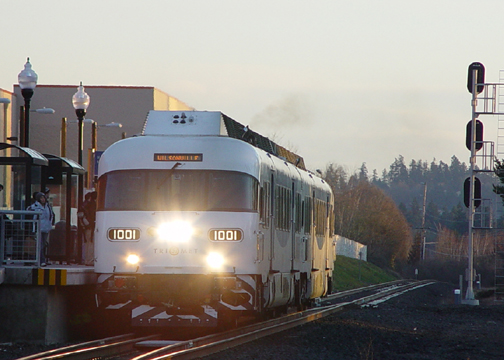 |
Oregon's first true commuter rail service has become part of the Portland area's transit network, carrying riders around the metro area and helping remove traffic from the region's congested road network. It represents the long efforts of local civic, government and transit advocacy groups. |
| The service, known as Westside Express Service or WES, operates between Beaverton and Wilsonville, using a combination of new and rebuilt trackage. This includes portions of the former Southern Pacific Tillamook Branch from Beaverton to Tigard, and the former Burlington Northern (Oregon Electric) line from Tigard to Wilsonville. These lines are currently operated by the Portland & Western Railroad. |
| TriMet operates it in partnership with the Portland & Western. The schedule has 16 round trips (eight each during the morning and evening rush hours). Trains operate in both directions every 30 minutes, and take approximately 27 minutes to run between the two endpoints. | 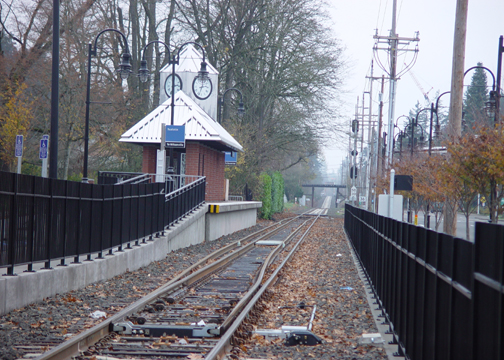 |
|
At the north end of the route, service begins at the Beaverton Transit Center, providing direct connections to two MAX routes (the Gresham-Hillsboro Blue Line and the Beaverton-Portland International Airport Red Line) and 11 bus lines. To reach the transit center, construction crews laid a new stretch of track along SW Lombard Street in downtown Beaverton from the existing right-of-way. |
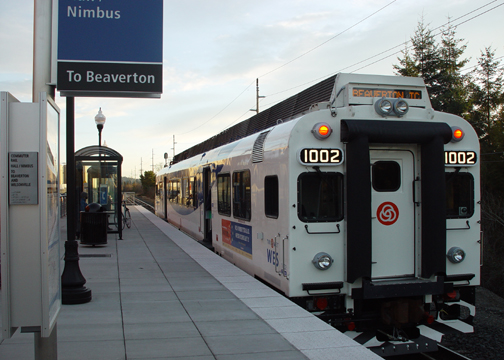 |
The route includes three intermediate stops. These are Hall-Nimbus, off Hall Boulevard near the Washington Square shopping complex; Tigard, on SW Commercial Street at the Tigard Transit Center; and Tualatin, along SW Boones Ferry Road on the west side of the downtown area. |
| The Tigard stop also provides direct connections to five TriMet bus routes. The Wilsonville terminus, on SW Barber Street, provides connections to three bus systems: South Metro Area Regional Transit (SMART); Canby Area Transit (CAT); and Salem Area Transit (Cherriots). Park-and-Ride lots are available at all stations except Beaverton Transit Center. |
| TriMet and the Oregon Department of Transportation sponsored a demonstration service on portions of this route as early as 1998. On Sep. 12-13, these trains operated in conjunction with the opening of the Westside MAX light rail line between Portland, Beaverton and Hillsboro. | 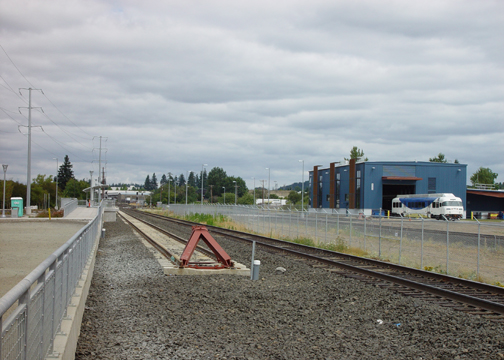 |
|
They connected with MAX trains at the Beaverton Creek light rail station using an adjacent freight spur. The trains used equipment provided by the Willamette & Pacific RR and the Pacific Northwest Chapter of the National Railway Historical Society. |
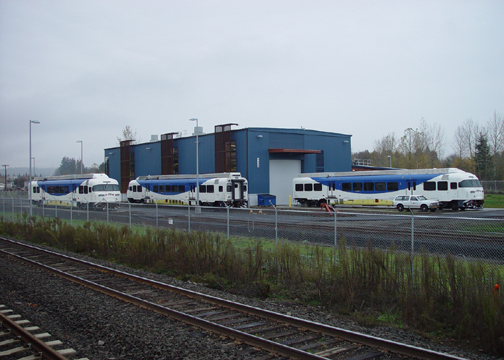 |
The project received both state and federal funding. Construction began in October 2006, and included the reconstruction of most of the grade crossings along the route, as well as installation of centralized traffic control, concrete crossties and continuous welded rail. |
| A new two-main-track alignment was constructed through Beaverton at the north end of the route, between SW Hall Boulevard and SW Lombard Street. The new track diverges from the existing former SP track at Lombard. Addditional stretches of double track were added between Tigard and Tualatin, and in Wilsonville just north of the station. Construction crews also built a maintenance shop in Wilsonville adjacent to the rail station. |
| The project also included a major right-of-way relocation through downtown Tigard. The former OE line was relocated next to the former SP, forming a single two-track right-of-way. The old OE right-of-way was removed. A new connection between the two lines was installed north of the Tigard stop. | 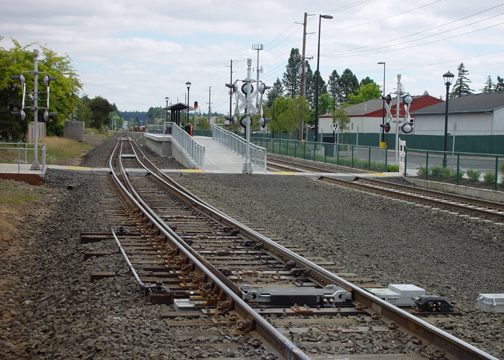 |
| A unique feature found at the three intermediate stops is the addition of a "gantlet" track section alongside the high-level platforms. This allows P&W trains with high-and-wide cars to operate through the station areas without hitting the platforms. P&W also received a Connect Oregon grant from the state to construct a small freight yard along the former SP line south of the Tigard Transit Center. |
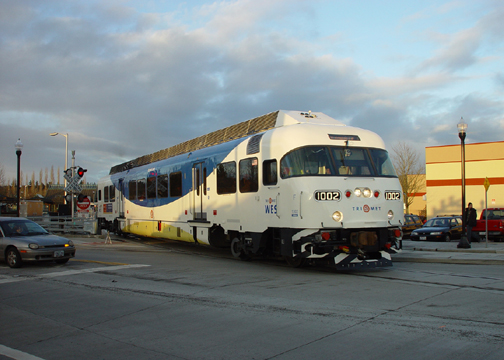 |
TriMet purchased three single-level diesel multiple unit (DMU) railcars and a cab-equipped trailer coach from Colorado Railcar. They provide both one-car and two-car trains. The first two cars (DMU #1001 and trailer coach #2001) arrived at the Wilsonville shops June 19, 2008. |
|
The remaining DMUs, #1002 and #1003, arrived in Wilsonville in early September 2008. The design is based on Colorado Railcar's Aero DMU, which demonstrated in the Portland area in November 2002. TriMet and P&W operated several test trips between Beaverton and Hillsboro, beginning at the Beaverton Creek MAX stop. Delays in delivery of the last two cars, as well as a new plan to add more safety equipment and signalling along the route, caused TriMet and P&W to delay the opening from October 2008 to February 2009. |
| Historically, the former SP portions of the route were part of the extensive Red Electric interurban network that operated south and west of Portland from 1915 to 1929. The former BN portions were part of the Oregon Electric interurban system that operated as far south as Eugene until 1933. | 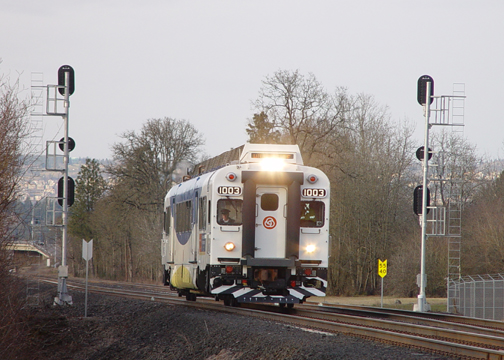 |
|
The $117.3 million project was funded by: $58.65 million in federal funding TriMet and Washington County are contributing a total of $4.1 million toward annual operating costs. |
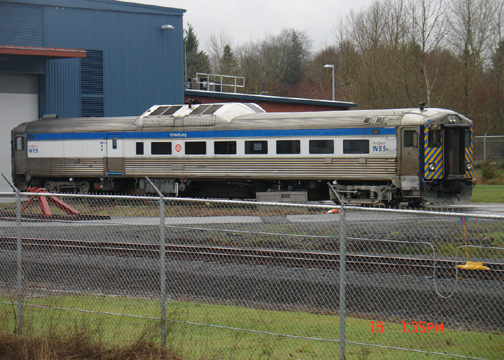 |
Meanwhile, officials in the Salem-Keizer area are looking to extend this route all the way to Salem. South of Wilsonville, a future route would continue along the old OE line through Donald, West Woodburn, Waconda and Keizer. |
|
Portland & Western handles dispatching for the route from its operations center in Albany, Ore. The small size of the rolling stock fleet caused TriMet to substitute buses on several occasions when one or more cars are in for maintenance or repairs. To provide spare equipment until more new cars can be purchased, TriMet purchased two Budd Rail Diesel Cars from the Alaska Railroad in October 2009. The two cars, an RDC-2 and an RDC-3, had their baggage compartments converted for bicycle carriage and disability access. They entered service Jan. 24, 2011. They normally operate when one or more of the Aero DMUs are out of service, running as a two-car set. TriMet paid $150,000 for the cars, and spent about $550,000 to upgrade them. TriMet purchased two additional RDC-1s in 2017 from the Trinity Railway Express service in the Dallas-Fort Worth, Texas metroplex. Once refurbished for WES operation, they will enter service as another backup trainset. Recent railroad media reports have mentioned that TriMet is looking at acquiring Nippon Sharyo/Sumitomo DMUs similar to those in operation on the Sonoma-Marin Area Rail Transit (SMART) regional rail operation in California and the Union Pearson Express in Toronto, Ontario. TriMet's projected southwest light rail line from Portland to Tualatin, once built, would serve the Tigard Transit Center as one of its intermediate stops, providing another intermodal link within the metropolitan area. Additional information, including schedules and a safety video, is available at the TriMet web site. |
| To navigate through the site, just click on one of the links in our image map. | |
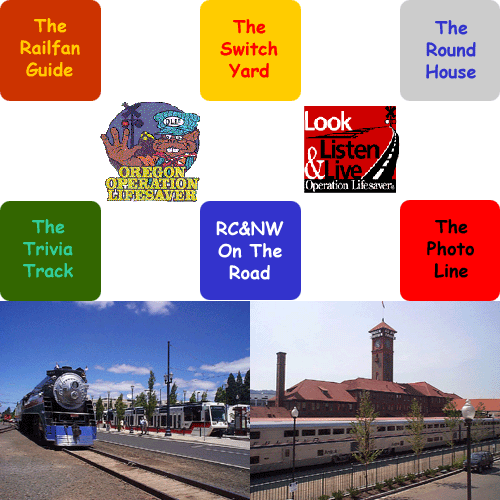 |